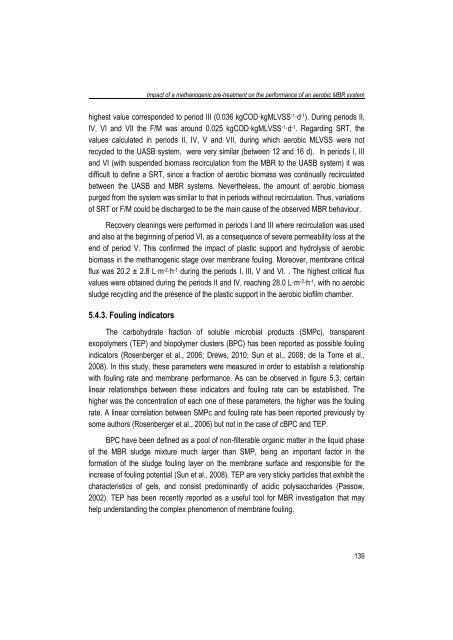Combining submerged membrane technology with anaerobic and ...
Combining submerged membrane technology with anaerobic and ...
Combining submerged membrane technology with anaerobic and ...
You also want an ePaper? Increase the reach of your titles
YUMPU automatically turns print PDFs into web optimized ePapers that Google loves.
Impact of a methanogenic pre-treatment on the performance of an aerobic MBR systemhighest value corresponded to period III (0.036 kgCOD·kgMLVSS -1·d -1 ). During periods II,IV, VI <strong>and</strong> VII the F/M was around 0.025 kgCOD·kgMLVSS -1·d -1 . Regarding SRT, thevalues calculated in periods II, IV, V <strong>and</strong> VII, during which aerobic MLVSS were notrecycled to the UASB system, were very similar (between 12 <strong>and</strong> 16 d). In periods I, III<strong>and</strong> VI (<strong>with</strong> suspended biomass recirculation from the MBR to the UASB system) it wasdifficult to define a SRT, since a fraction of aerobic biomass was continually recirculatedbetween the UASB <strong>and</strong> MBR systems. Nevertheless, the amount of aerobic biomasspurged from the system was similar to that in periods <strong>with</strong>out recirculation. Thus, variationsof SRT or F/M could be discharged to be the main cause of the observed MBR behaviour.Recovery cleanings were performed in periods I <strong>and</strong> III where recirculation was used<strong>and</strong> also at the beginning of period VI, as a consequence of severe permeability loss at theend of period V. This confirmed the impact of plastic support <strong>and</strong> hydrolysis of aerobicbiomass in the methanogenic stage over <strong>membrane</strong> fouling. Moreover, <strong>membrane</strong> criticalflux was 20.2 ± 2.8 L·m -2·h -1 during the periods I, III, V <strong>and</strong> VI. . The highest critical fluxvalues were obtained during the periods II <strong>and</strong> IV, reaching 28.0 L·m -2·h -1 , <strong>with</strong> no aerobicsludge recycling <strong>and</strong> the presence of the plastic support in the aerobic biofilm chamber.5.4.3. Fouling indicatorsThe carbohydrate fraction of soluble microbial products (SMPc), transparentexopolymers (TEP) <strong>and</strong> biopolymer clusters (BPC) has been reported as possible foulingindicators (Rosenberger et al., 2006; Drews, 2010; Sun et al., 2008; de la Torre et al.,2008). In this study, these parameters were measured in order to establish a relationship<strong>with</strong> fouling rate <strong>and</strong> <strong>membrane</strong> performance. As can be observed in figure 5.3, certainlinear relationships between these indicators <strong>and</strong> fouling rate can be established. Thehigher was the concentration of each one of these parameters, the higher was the foulingrate. A linear correlation between SMPc <strong>and</strong> fouling rate has been reported previously bysome authors (Rosenberger et al., 2006) but not in the case of cBPC <strong>and</strong> TEP.BPC have been defined as a pool of non-filterable organic matter in the liquid phaseof the MBR sludge mixture much larger than SMP, being an important factor in theformation of the sludge fouling layer on the <strong>membrane</strong> surface <strong>and</strong> responsible for theincrease of fouling potential (Sun et al., 2008). TEP are very sticky particles that exhibit thecharacteristics of gels, <strong>and</strong> consist predominantly of acidic polysaccharides (Passow,2002). TEP has been recently reported as a useful tool for MBR investigation that mayhelp underst<strong>and</strong>ing the complex phenomenon of <strong>membrane</strong> fouling.139
















